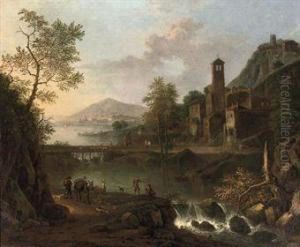Jan Van Huijsum Paintings
Jan van Huysum was a Dutch painter during the 18th century, renowned for his sumptuous still-life paintings which featured flowers and fruit. Born into an artistic family on April 15, 1682, in Amsterdam, Netherlands, his father, Justus van Huysum, was also a painter and no doubt influenced Jan's early artistic training and development. Jan went on to surpass the fame and skill of his father, becoming one of the most celebrated still-life painters of his time.
Van Huysum's work is characterized by meticulous attention to detail, vibrant colors, and an advanced technique of rendering light and texture that gives his paintings a nearly photographic quality. He is best known for his floral arrangements, which are often composed of a variety of flowers from different seasons and locations in a single vase, demonstrating not only the artist's technical skill but also his extensive knowledge of botany. His compositions were dynamic and often complex, with an abundance of flowers, fruit, and sometimes insects or shells, all rendered with a high degree of realism.
Despite the popularity of his work, van Huysum was known to be secretive about his techniques, going to great lengths to guard his methods from rival artists. He was highly successful and his paintings were sought after by wealthy patrons and collectors across Europe. Van Huysum's influence extended beyond his lifetime, contributing significantly to the development of the still-life genre in Europe.
Jan van Huysum's career thrived in the context of the Dutch Golden Age, a period when the Netherlands experienced great wealth, cultural achievements, and a keen interest in horticulture and the natural sciences. This cultural backdrop helped foster the appreciation for the detailed and lifelike depictions found in van Huysum's work. He continued to paint until his death on February 8, 1749, in Amsterdam. His legacy is preserved in the works held by major museums around the world, including the Rijksmuseum in Amsterdam, the J. Paul Getty Museum in Los Angeles, and The Hermitage in St. Petersburg.
